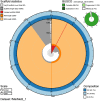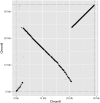Screening a new European hake (Merluccius merluccius) chromosome-level genome assembly suggests an XX/XY sex-determining system driven by the SRY-box transcription factor 3 (sox3)
- PMID: 40488516
- PMCID: PMC12341869
- DOI: 10.1093/g3journal/jkaf127
Screening a new European hake (Merluccius merluccius) chromosome-level genome assembly suggests an XX/XY sex-determining system driven by the SRY-box transcription factor 3 (sox3)
Abstract
Sex determination is exceptionally diverse and shows a high evolutionary rate in fish. European hake (Merluccius merluccius) is a species of great commercial value distributed throughout European coasts, which displays a significant sexual growth dimorphism. We present a chromosome-level genome of M. merluccius, composed of 215 contigs using long- and short-read sequencing, further scaffolded into the species' 21 chromosomes using Hi-C technique (715 Mb). RNA-seq on several tissues from pooled individuals improved annotation (26,625 protein-coding genes and 11,083 ncRNAs). Five males and 5 females from an Atlantic population were re-sequenced at 30× depth to look for association with sex across the whole genome. Genetic differentiation between males and females (FST) and intrapopulation fixation index (FIS) pointed to a region on chromosome 9 spanning ∼10 Mb which included several genes related to gonad differentiation and showed strong linkage disequilibrium associated with a putative inversion. Near sox3 gene (∼25 kb), SNPs were mostly heterozygous in males and homozygous in females, consistent with an XX/XY sex-determining (SD) system. These SNP markers were validated in a larger sample of 56 males and 63 females from the same population using MassARRAY. Other genomic regions that were differentiated between males and females and suggestive of sexual conflict were also explored across the genome. Results support a candidate master SD gene in M. merluccius and indicate some differentiated regions potentially under sexual conflict. This information will be useful for the fisheries management of M. merluccius in the context of climate change, where noninvasive sex identification tools are essential.
Keywords: MassARRAY; genetic differentiation; genome assembly; intraspecific variation; sex-determination evolution; sexual conflict; whole-genome sequencing.
© The Author(s) 2025. Published by Oxford University Press on behalf of The Genetics Society of America.
Conflict of interest statement
Conflicts of interest: The authors declare no conflicts of interest.
Figures




Similar articles
-
Independent contribution of gonads and sex chromosomes to sex differences in bone mass and strength in the four-core genotypes mouse model.J Bone Miner Res. 2024 Oct 29;39(11):1659-1672. doi: 10.1093/jbmr/zjae147. J Bone Miner Res. 2024. PMID: 39255371
-
The genome of Hippophae salicifolia provides new insights into the sexual differentiation of sea buckthorn.Gigascience. 2025 Jan 6;14:giaf046. doi: 10.1093/gigascience/giaf046. Gigascience. 2025. PMID: 40601420 Free PMC article.
-
Sexual Harassment and Prevention Training.2024 Mar 29. In: StatPearls [Internet]. Treasure Island (FL): StatPearls Publishing; 2025 Jan–. 2024 Mar 29. In: StatPearls [Internet]. Treasure Island (FL): StatPearls Publishing; 2025 Jan–. PMID: 36508513 Free Books & Documents.
-
Systemic pharmacological treatments for chronic plaque psoriasis: a network meta-analysis.Cochrane Database Syst Rev. 2020 Jan 9;1(1):CD011535. doi: 10.1002/14651858.CD011535.pub3. Cochrane Database Syst Rev. 2020. Update in: Cochrane Database Syst Rev. 2021 Apr 19;4:CD011535. doi: 10.1002/14651858.CD011535.pub4. PMID: 31917873 Free PMC article. Updated.
-
Systemic pharmacological treatments for chronic plaque psoriasis: a network meta-analysis.Cochrane Database Syst Rev. 2021 Apr 19;4(4):CD011535. doi: 10.1002/14651858.CD011535.pub4. Cochrane Database Syst Rev. 2021. Update in: Cochrane Database Syst Rev. 2022 May 23;5:CD011535. doi: 10.1002/14651858.CD011535.pub5. PMID: 33871055 Free PMC article. Updated.
References
-
- Apostologamvrou C, Vlachou M, Theocharis A, Ntavaros C, Klaoudatos D. 2023. Reproductive aspects of European hake, (Merluccius merluccius, Linnaeus, 1758) based on histological depiction of both sexes in the Eastern Mediterranean (Aegean Sea). Reg Stud Mar Sci. 68:103281. doi: 10.1016/j.rsma.2023.103281. - DOI
MeSH terms
Substances
Grants and funding
LinkOut - more resources
Full Text Sources
Miscellaneous
